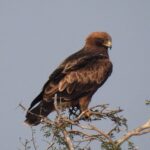Booted eagles are opportunistic predators that feed on a variety of small and medium-sized prey, including birds, small mammals, reptiles, and large insects. While the exact frequency of their feeding is not explicitly stated, it can be inferred that they eat based on their hunting success and the availability of their preferred prey.
Booted Eagles’ Hunting Techniques and Prey
Booted eagles are known to employ a variety of hunting techniques to catch their prey. They often hunt on the wing, using their keen eyesight to spot potential targets from a distance. When they spot a suitable prey, they will quickly fold their wings and swoop down in a fast, almost vertical dive to catch their target.
In terms of their prey, booted eagles have a diverse diet that includes:
- Small and medium-sized birds, such as songbirds, pigeons, and small waterfowl
- Small mammals, such as mice, voles, and rabbits
- Reptiles, such as lizards and snakes
- Large insects, such as grasshoppers and beetles
Studies have shown that the specific composition of a booted eagle’s diet can vary depending on the region and the availability of different prey species. For example, in southern Africa, birds are the most common prey, making up a significant portion of their diet.
Frequency of Feeding
 Image source: Booted eagle By Dr. Raju Kasambe
Image source: Booted eagle By Dr. Raju Kasambe
While the exact frequency of feeding for booted eagles is not explicitly stated, it can be inferred that they eat based on their hunting success and the availability of their preferred prey. As opportunistic predators, booted eagles are likely to feed whenever they are able to successfully capture a suitable prey item.
Some key factors that may influence the frequency of feeding for booted eagles include:
- Prey availability: The abundance and accessibility of their preferred prey species can impact how often they are able to successfully hunt and feed.
- Seasonal changes: Migratory patterns and changes in prey populations throughout the year may affect the frequency of feeding for booted eagles.
- Individual factors: The age, health, and breeding status of individual booted eagles may also influence their feeding frequency.
Conservation Concerns
Despite their widespread distribution, there is a lack of research on the booted eagle, particularly in terms of their population status and conservation needs. In some regions, changes in human land use and habitat loss may have driven changes in their migration patterns, and this species may have been overlooked due to the remote and discrete nature of their nesting sites.
To better understand the conservation status of booted eagles, more research is needed on their population dynamics, feeding habits, and the threats they face in their various habitats. This information can help inform conservation efforts and ensure the long-term survival of this fascinating raptor species.
Conclusion
Booted eagles are opportunistic predators that feed on a variety of small and medium-sized prey, including birds, small mammals, reptiles, and large insects. While the exact frequency of their feeding is not explicitly stated, it can be inferred that they eat based on their hunting success and the availability of their preferred prey.
To better understand the feeding habits and conservation needs of booted eagles, more research is needed on this migratory species. By studying their population dynamics, feeding patterns, and the threats they face, we can work to ensure the long-term survival of this fascinating raptor.
References:
– Booted Eagle Fact Sheet
– Booted Eagle on Wikipedia
– Booted Eagle on Oiseaux-Birds.com

